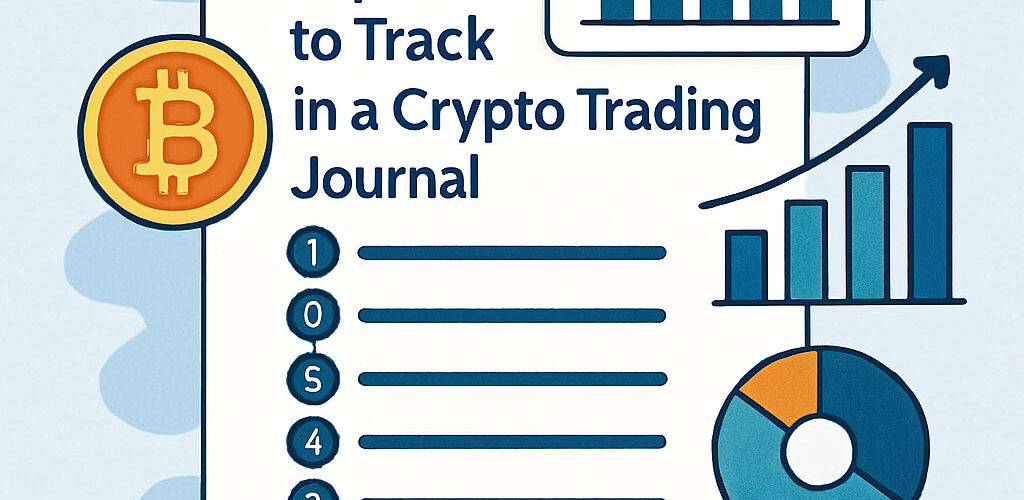Top 7 Metrics to Track in a Crypto Trading Journal

Successful crypto traders know that trading is not just about charts and market news—it’s also about self-awareness and performance tracking. A well-structured crypto trading journal allows you to analyze your trades, understand your habits, and refine your strategy over time. By logging the right metrics, you gain a clearer picture of what’s working, what’s not, and where you can improve. In this guide, we’ll cover the top 7 metrics you should be tracking in your crypto trading journal to maximize your growth and profitability.
1. Entry and Exit Points
Your journal should clearly document where you entered and exited each trade. This includes the exact price levels, the exchange used, and whether you placed a market or limit order. By reviewing this over time, you’ll notice whether you tend to enter too early, exit too late, or consistently miss better setups. This metric provides the foundation for evaluating all other aspects of your trading strategy.
2. Position Size
Tracking your position size is critical for risk management. Your journal should show how much capital you allocated per trade and whether it was within your risk tolerance (e.g., no more than 1–2% of total portfolio per trade). By comparing outcomes against position size, you’ll see if larger trades tend to be more emotional or if smaller trades lack conviction.
3. Risk-to-Reward Ratio
Every trade should be entered with a clear risk-to-reward ratio (RRR) in mind. A ratio of 1:2 means you risk 1 unit to gain 2 units. By recording this metric, you can check if your actual trades align with your intended setups. Over time, this helps refine your ability to spot high-quality opportunities rather than chasing impulsive trades.
| Risk-to-Reward Ratio | Probability of Success Needed | Example |
|---|---|---|
| 1:1 | 50% | Risk $100 to make $100 |
| 1:2 | 33% | Risk $100 to make $200 |
| 1:3 | 25% | Risk $100 to make $300 |
4. Trade Duration
How long you hold a trade reveals whether your style leans toward scalping, day trading, swing trading, or position holding. Recording trade duration highlights whether your chosen timeframes are aligned with your personality and strategy. For example, if you often plan for swing trades but close within hours due to anxiety, you may need to refine your approach.
5. Emotions and Mindset
Numbers don’t tell the whole story. Logging your emotional state before, during, and after trades helps uncover patterns that might sabotage performance. Did you feel fear, greed, or overconfidence? By reviewing emotional notes, you’ll better understand your psychological triggers and build discipline—one of the most powerful advantages in crypto trading.
For more reasons to use a trading journal, see how tracking your mindset can be just as valuable as tracking numbers.
6. Fees and Costs
Crypto exchanges charge different fees for spot, margin, and futures trading. Over time, fees can significantly eat into profits. By recording every commission, funding rate, and slippage, you’ll get a true picture of your net performance rather than just focusing on gross gains.
7. Win Rate and Expectancy
Your win rate (percentage of winning trades) and expectancy (average return per trade) are two of the most important metrics in your trading journal. They reveal whether your strategy is profitable over time, regardless of individual wins or losses. Expectancy can be calculated as:
Expectancy = (Win Rate × Average Win) – (Loss Rate × Average Loss)
By tracking this, you can refine your system to maximize profits while minimizing drawdowns.
Pros and Cons of Tracking Metrics
| Pros | Cons |
|---|---|
| Identifies profitable patterns | Requires consistent effort to maintain |
| Improves discipline and self-awareness | May feel time-consuming at first |
| Provides data-driven decision making | Risk of over-analyzing small sample sizes |
Star Rating of Journaling Effectiveness
Based on trader feedback, here’s how valuable tracking each metric can be:
- Entry & Exit Points ⭐⭐⭐⭐⭐
- Position Size ⭐⭐⭐⭐☆
- Risk-to-Reward Ratio ⭐⭐⭐⭐⭐
- Trade Duration ⭐⭐⭐⭐☆
- Emotions & Mindset ⭐⭐⭐⭐⭐
- Fees & Costs ⭐⭐⭐☆
- Win Rate & Expectancy ⭐⭐⭐⭐⭐
Final Thoughts
Keeping a crypto trading journal isn’t just about documenting numbers—it’s about building a structured system that supports your growth. By tracking these 7 core metrics, you’ll uncover hidden patterns, control your emotions, and optimize your strategies. Over time, this process transforms raw market experience into refined trading wisdom. If you’re serious about becoming a consistently profitable trader, make journaling a cornerstone of your daily routine.
If you found this content helpful,please consider sharing!:


